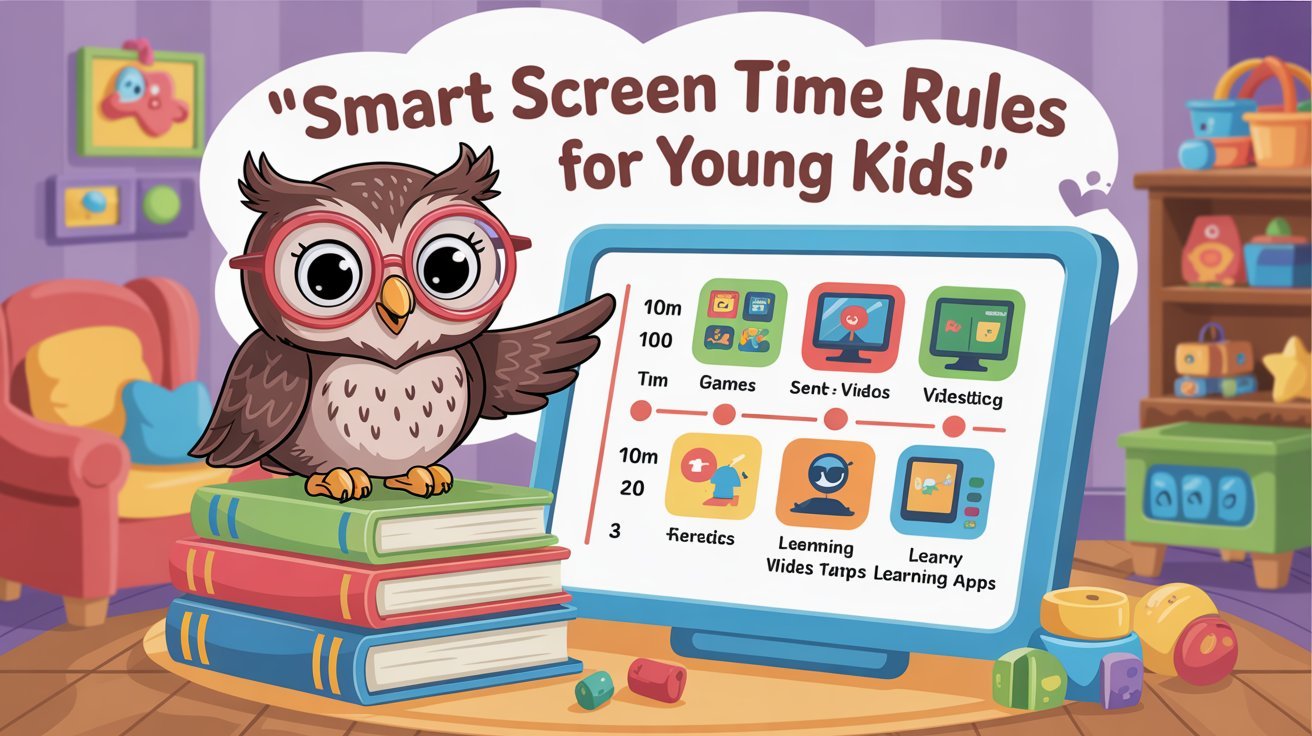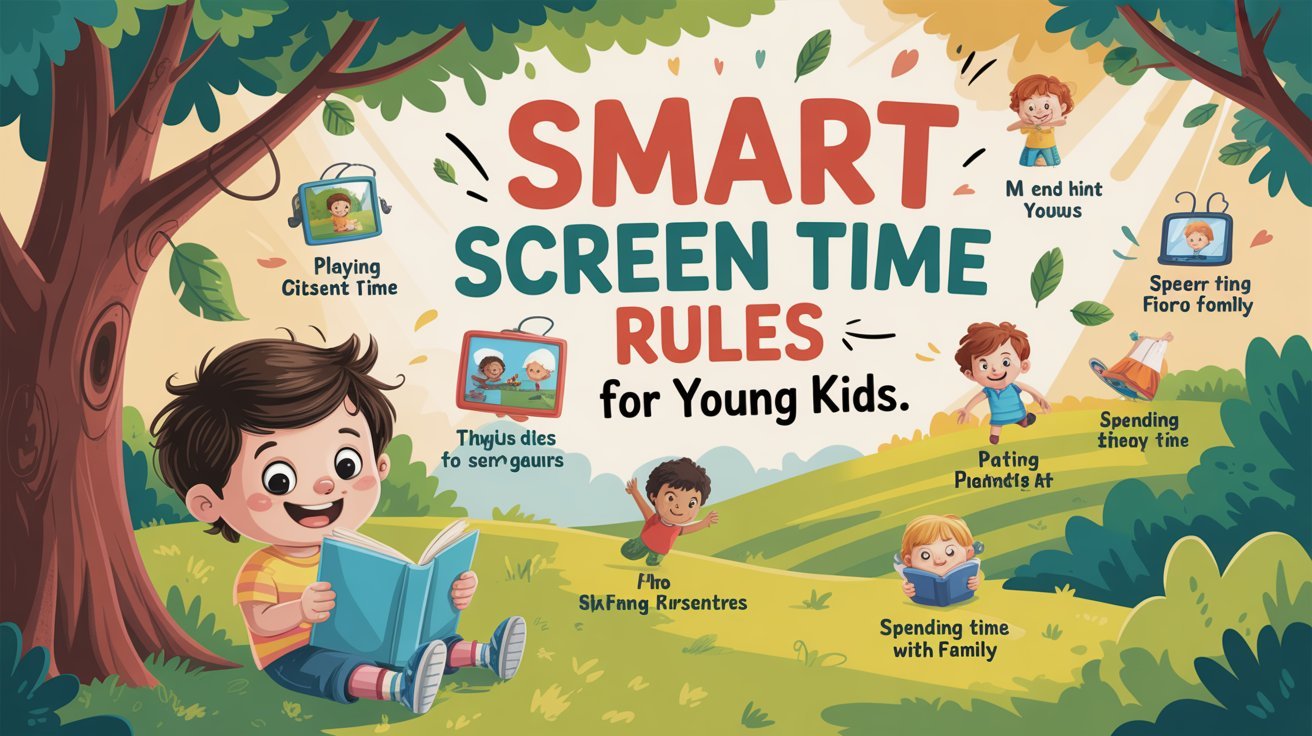Many parents wonder how to set screen time rules for young kids that are both fair and healthy. Smart screen time rules balance the need for learning and play with limits that protect a child’s development and well-being. This helps kids enjoy technology without it taking over other important parts of life.
It is important to create clear and consistent rules that fit the child’s age and daily routine. Rules should encourage breaks, physical activity, and time spent with family. By setting these limits early, parents can help children develop good habits around screens that last a lifetime.
The Importance of Smart Screen Time Rules
Setting smart screen time limits helps protect children’s brain development and supports healthy daily routines. It also ensures screen use does not interfere with sleep, physical activity, or social skills.
Impact of Screen Time on Child Development
Too much screen time can affect a child’s brain growth, especially in early years. It may reduce attention span and cause difficulty with learning and memory. Screens can also limit playtime, which is vital for motor skills and creativity.
Excess screen use is linked to sleep problems. Bright screens before bed can make it harder for children to fall asleep and get enough rest. Poor sleep affects mood, focus, and overall health.
Children need variety in activities like reading, talking, and playing outside. Balanced screen time supports better language development and social skills.

Why Guidelines Matter for Young Kids
Clear screen time rules help parents create healthy routines. When limits are set, children learn to balance screen use with other important activities.
Guidelines also protect children from harmful content. Parental controls combined with time limits reduce exposure to inappropriate material.
Rules promote consistent habits. For example, no screens during meals or right before bedtime encourages family interaction and better sleep. Simple rules make it easier for both parents and children to follow healthy screen habits.
Setting Age-Appropriate Screen Time Limits
Screen time limits need to fit each child’s age and developmental stage. Younger kids require stricter controls and more adult interaction during screen use. The rules should help balance learning, play, and rest.
Recommendations for Infants and Toddlers
For children under 2 years old, screen time should be very limited. Experts suggest avoiding screen use except for video calls with family. This age is crucial for brain growth through real-world experiences.
If screens are used, parents should actively engage with their child, explaining what they see. This helps make screen time more educational and social.
At this stage, slow and simple videos, with clear sounds and images, work best. Parents should also watch for signs of tiredness or overstimulation to avoid negative effects.
Guidelines for Preschoolers
Children aged 3 to 5 can have up to 1 hour of screen time per day. Quality of content matters more than quantity. Educational shows, apps, and games that promote creativity and problem-solving are preferred.
Parents should be present during screen use to answer questions and guide learning. This helps children understand and retain information better.
Screen time should not replace physical activity, play, or sleep. Setting regular times for screens, like after homework or meals, helps create a healthy routine.
| Age Group | Daily Screen Time Limit | Key Tips |
|---|---|---|
| Infants (0-2) | Avoid except video calls | Engage together, keep it brief and simple |
| Preschoolers (3-5) | Up to 1 hour | Choose educational content, co-viewing |
Creating Healthy Tech Habits
Good screen habits start with clear examples and steady routines. It helps when adults show how to use devices carefully and when families agree on consistent rules for screen time. Both actions make it easier for kids to balance tech use with other activities.
Role Modeling Positive Screen Use
Adults influence kids by how they use screens. When parents limit their own device time, it shows children that screens are not the main focus. For example, putting phones away during meals or family time sets a clear example.
Using screens for learning or creativity, rather than only entertainment, is another way to model good habits. Adults who take breaks from screens regularly teach kids the importance of rest and movement.

Establishing Consistent Rules
Setting specific screen time limits helps children understand boundaries. Families can decide on daily or weekly hours and stick to them. Writing these rules down and posting them somewhere visible can remind everyone.
Rules about when and where screens are allowed make habits easier to follow. For instance, no devices in bedrooms or during homework time helps kids avoid distractions. Consistency in enforcing these rules is key to success.
Choosing High-Quality Digital Content
Parents should pick digital content that is safe, age-appropriate, and offers real value. It’s important to look for apps, games, and shows that promote learning and positive messages. The right choices help kids use screen time meaningfully.
Evaluating Apps, Games, and Shows
Look for content made for the child’s age group. Check if it has clear educational goals or helps develop skills like problem-solving or creativity. Avoid apps with too many ads or in-app purchases that can confuse young kids.
Read reviews from other parents and experts. Check if the content respects the child’s privacy and has no violent or inappropriate material. Using trusted sources or ratings can make selection easier.
Keep an eye on how the child reacts to the content. If it frustrates or upsets them, it might not be a good fit.
Encouraging Educational Experiences
Choose content that encourages interaction rather than passive watching. Games that require thinking or shows that ask questions help kids stay engaged and learn more.
Look for programs that teach letters, numbers, or social skills. Some apps guide parents to join in, which boosts learning.
Balance is key. Mixing fun and education motivates kids to enjoy screen time and gain skills without feeling pressured.
Balancing Screen Time With Offline Activities
Finding a good mix between screen use and offline activities helps children develop healthy habits. Encouraging active play and spending quality time with family without screens are key steps in this balance.
Promoting Active Play and Social Interaction
Active play supports physical health and improves coordination. Children should have at least one hour a day of activities like running, jumping, or riding a bike. These activities help build strong muscles and bones.
Social interaction is also important. Playing with friends or family teaches communication and cooperation skills. Outdoor games, sports, and group activities offer chances to practice teamwork and make new friends.

Parents can help by setting limits on screen time and encouraging kids to try new activities. Simple changes like choosing walks or bike rides over screen use promote balanced habits that benefit both mind and body.
Incorporating Family Screen-Free Time
Setting aside time without screens allows families to connect and build trust. Family meals, board games, or reading together are ways to spend meaningful time without devices.
Parents can create regular routines, such as a daily “no screen hour” or screen-free weekends. This signals that time together is important and not replaced by devices.
Clear rules about screen use during certain times help children understand expectations. These habits encourage better communication and reduce distractions, making family time more focused and enjoyable.
Establishing Device-Free Zones and Times
Creating clear rules about when and where screens can be used helps children develop healthy habits. It limits distractions and supports better focus and sleep.
Screen-Free Bedrooms and Mealtimes
Bedrooms should be kept free of screens to promote rest and reduce distractions. When children have devices in their rooms, it is easier for them to use screens late into the night. Removing phones, tablets, and TVs from bedrooms encourages better sleep quality.
Mealtimes are another key opportunity to set device-free zones. Turning off all screens during family meals helps kids focus on eating and talking with others. This improves communication and builds stronger family bonds.
A simple rule could be: no screens in bedrooms and no devices at the dinner table. Setting these clear limits makes it easier for children to follow.
Managing Screen Use Before Bedtime
Using screens within an hour before bedtime can make it harder for children to fall asleep. The blue light from devices affects their natural sleep cycles.
Parents can set a “screen curfew” by turning off devices at least 60 minutes before bed. Instead, children might read a book or do quiet activities to help them relax.
Lowering the brightness on devices or using night mode does not fully solve the problem. The best option is to avoid any screen time during this period to support better sleep habits.
Monitoring, Supervision, and Parental Controls
Careful monitoring and active supervision help keep screen time safe and productive for young kids. Using parental controls can also limit what children access and for how long. Together, these methods guide healthy screen habits.
Co-Viewing and Engaging With Kids Online
Parents should spend time with their children during screen use. This means watching shows or playing games together, asking questions, and talking about what they see.
Co-viewing helps parents understand the content and check if it’s age-appropriate. It also gives kids a chance to share their thoughts and learn from safe conversations.
Engagement builds trust and makes screen time a shared experience. It reduces the chance of kids encountering harmful or confusing material alone. Parents can model good behavior and encourage critical thinking while online.
Utilizing Parental Controls Effectively
Parental controls restrict access to apps, websites, and times kids can use devices. Parents should choose settings based on the child’s age and maturity.
Most devices and apps have built-in controls that can block content, limit screen time, and set passwords. It’s important to update these settings regularly and review any new apps or updates.
Parents should balance limits with some freedom to explore. Controls work best when combined with conversations about online safety and respectful use. Clear rules help children understand why limits are set and follow them better.
Addressing Common Challenges
Setting screen time limits can lead to tough moments, but clear strategies help manage reactions and adapt rules over time. Kids’ needs and behaviors change, so flexibility and consistency are both needed.
Handling Screen Time Tantrums
When kids throw tantrums over screen limits, staying calm is key. Parents should avoid giving in to demands, as this teaches the child that tantrums work. Instead, explaining the reason for rules in simple words helps children understand.
Using a visual schedule for screen time can prepare kids for transitions. A timer that shows when screen time ends can make the change less sudden. Praise for stopping without fuss encourages good behavior.
If tantrums happen often, parents can also offer alternatives like reading, drawing, or playing outside. This redirects the child’s attention and reduces frustration.
Adjusting Rules as Kids Grow
Screen time rules need to change as children get older. Toddlers require strict limits and close supervision. School-age kids may have homework or online learning, which makes screen use more flexible.
Parents should review rules every few months. This includes checking how much time kids spend on educational versus entertainment content. More privileges might come with age, but clear boundaries about when and how screens are used remain important.
Families can create a simple chart to track screen time goals and responsibilities. Regular talks about screen habits help kids learn to self-regulate and prepare for more freedom.
Communicating Expectations With Caregivers
Clear communication helps keep screen time limits consistent for children. Everyone involved should know the rules, reasons, and how to handle requests or exceptions.
Aligning With Family Members and Childcare Providers
Families and childcare providers must agree on screen time rules to avoid confusion. They should share details about allowed devices, time limits, and types of content that are okay.
Using written guidelines can help. For example:
| Rule | Details |
|---|---|
| Screen time allowed | 1 hour per day |
| Devices | Tablet and TV only |
| Content | Educational programs |
Regular talks or messages between caregivers ensure new updates or changes are understood. Everyone should also support asking kids for feedback to keep rules age-appropriate and reasonable.
Reviewing and Updating Rules Over Time
Kids grow and change quickly, so screen time rules need to change too. Parents should check the rules every few months to see if they still work.
As children get older, their needs and interests shift. Parents can adjust time limits and types of allowed activities to match their child’s age and maturity.
It helps to talk with the child about how they feel about the rules. This can make the rules more fair and clear.
Here is a simple guide for reviewing rules:
| Step | What to Do |
|---|---|
| Check Usage | Look at how much and what devices are used |
| Evaluate Impact | Notice how screen time affects behavior, sleep, and school |
| Adjust Limits | Change time limits or content as needed |
| Communicate | Discuss changes and reasons with the child |
Updating screen rules also means adding new rules if problems arise. For example, if screen time starts to affect sleep, stricter limits may be needed.
By reviewing and updating rules regularly, parents keep control while supporting healthier habits.














